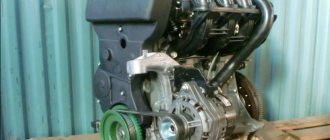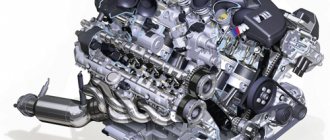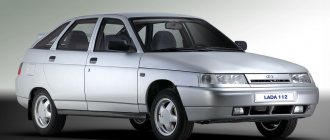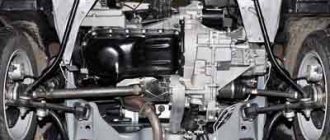- Engines
- VAZ
- 21126
The 1.6-liter 16-valve VAZ 21126 engine appeared in 2007 along with the Lada Priora and then spread to almost the entire model range of the Russian company AvtoVAZ. This unit was also often used as a blank for the concern’s sports engines.
The VAZ 16V line also includes: 11194, 21124, 21127, 21129, 21128 and 21179.
- Characteristics
- Description
- Consumption
- Application
- Reviews
- Service
- Breakdowns
- Prices
Technical characteristics of the VAZ 21126 1.6 16kl engine
| Type | in-line |
| Number of cylinders | 4 |
| Number of valves | 16 |
| Exact volume | 1597 cm³ |
| Cylinder diameter | 82 mm |
| Piston stroke | 75.6 mm |
| Supply system | injector |
| Power | 98 hp |
| Torque | 145 Nm |
| Compression ratio | 10.5 – 11 |
| Fuel type | AI-92 |
| Environmental standards | EURO 3/4 |
| Type | in-line |
| Number of cylinders | 4 |
| Number of valves | 16 |
| Exact volume | 1597 cm³ |
| Cylinder diameter | 82 mm |
| Piston stroke | 75.6 mm |
| Supply system | injector |
| Power | 114 – 118 hp |
| Torque | 150 – 154 Nm |
| Compression ratio | 11 |
| Fuel type | AI-92 |
| Environmental standards | EURO 4/5 |
| Type | in-line |
| Number of cylinders | 4 |
| Number of valves | 16 |
| Exact volume | 1597 cm³ |
| Cylinder diameter | 82 mm |
| Piston stroke | 75.6 mm |
| Supply system | injector |
| Power | 136 hp |
| Torque | 154 Nm |
| Compression ratio | 11 |
| Fuel type | AI-92 |
| Environmental standards | EURO 5 |
Design features of the Lada 21126 16 valve engine
The main difference between this internal combustion engine and its predecessors is the widespread use of foreign components in the assembly. First of all, this concerns a lightweight connecting rod and piston group manufactured by Federal Mogul, as well as a timing belt with an automatic tensioner from Gates.
Due to the strict requirements of the American company, the manufacturer of ShPG, additional procedures are carried out on the conveyor for processing the surfaces of the block, as well as honing the cylinders. There were also some disadvantages here: new pistons without holes made the power unit plug-in. Update: from mid-2022, the engines received an update in the form of plugless pistons.
Otherwise, everything is familiar here: a cast-iron block, which traces its history back to the VAZ 21083, a 16-valve aluminum head with two camshafts, standard for VAZ products, the presence of hydraulic compensators eliminates the need to adjust the valve clearances.
The video shows the consequences of a broken timing belt and subsequent head repair.
Gates timing drive design
The VAZ 21126 engine uses a new mechanism for automatically tensioning the toothed belt and gas distribution mechanism, which has rollers of an advanced design. The timing belt from the German manufacturer Gates has a new oval tooth profile. In this regard, pulleys with a similar profile are installed on the internal combustion engine on the camshaft, water pump shaft and crankshaft. The profile of the working surface of the pulley coincides with the profile of the semicircular tooth of the timing belt. The belt from the German manufacturer Gates has a width of 22 mm, 137 teeth, its marking is 76137x22. The manufacturer guarantees a product service life of up to 200 thousand km.
However, this should not be trusted. Unscrupulous manufacturers have appeared that produce counterfeit products from well-known brands. The appearance of the fake is the same as that of the genuine product. It is not possible to visually distinguish a low-quality belt. Therefore, there are complaints from drivers of a broken timing belt with a mileage of less than 100 thousand km. And the design of the pistons is such that when the timing belt breaks, mechanical damage to the ShPG parts occurs.
"Lada Priora"
"Lada Priora" replaced the 10th series "VAZ". The differences between them are visible to the naked eye. The designers made many changes to both the external and internal design. All changes were first tested on the Lada Kalina, so the Priora turned out to be of very high quality. The first model was presented in 2003, but the car went on mass sale in 2007, when it was finally finalized. Externally, the new Lada resembled something between the old “ten” and Western foreign cars. For example, the rear of the Priora was taken from Opel cars.
Design
The car is equipped with an airbag, power steering and power windows. The Lada Priora has a high level of safety: the body is made of solid metal, and the airbag is deployed upon impact. Thanks to its low cost and good technical characteristics, the car quickly became popular. Although a little awkward at first glance, the Lada was designed for Russian roads and has many advantages. It has both high ground clearance and a spacious interior. Consumables for a car are relatively inexpensive, so in case of repairs, the car owner will not need to spend his entire fortune on purchasing parts.
Internal "stuffing"
Compared to the VAZ-2110, the Priora looks much lighter and more mobile. The whole point lies in the completely redesigned bumpers and rear axle of the car, which received a new design. The interior details also received an update. The ground clearance is 165 cm, which is ideal for light off-road conditions and Russian roads. The engineers also took care of savings: fuel consumption per 100 km is only 5-8 liters, depending on the driving mode. The maximum speed of the VAZ-2170 is quite high - 183 km/h. On the highway the car can move at a comfortable speed of 110 km/h. The Priora can accelerate to 100 km in 12 seconds, which is standard for cars in this category.
But the new Lada model is good not only internally. Attention was also paid to the interior of the car, the design of which was developed by a young Italian company. Only high quality materials are used in the manufacture of the machine, there are no gaps between the seams, and overall the model looks very European. The range includes several body options and color schemes, which allows each buyer to choose exactly the option that suits him best. But the main thing in a car is the engine, and it is this that determines its power and character. What can you say about the Lada Priora engine?
Engine test tables and graphs
As you can see from the table, the power of the 1.8-liter engine has a positive effect on its dynamics and even consumption. It would seem that it is fuel consumption that should increase, but test results prove the opposite.
Engine power
In this graph, the favorite is immediately visible; there are practically no equal to the 1.8-liter engine.
Source
Engine 8 valves
Lada Priora received several updates during its production. This is logical, because industry does not stand still, and more advanced technologies are constantly appearing in the world. The first models were equipped with an 8-valve engine, which received a lot of criticism. The four-stroke engine is equipped with fuel injection, which allows you to start the car even in sub-zero temperatures. Four cylinders are located on the same line, they correspond to 8 valves. The sedan does not weigh that much, so its ride is light and smooth. Such a car does not need a powerful engine, so the creators of the Priora decided that such an engine would be quite sufficient. The Priora engine (VAZ-2170) with 8 valves has the following characteristics:
16 valve engine
Soon after the launch of Lada Priora production, some cars began to be equipped with 16-valve engines of model 21126. Technically, models with 8 and 16 valves differ quite significantly. The design of the 16-valve engine is different in that in the upper part it has not one shaft, but two. Accordingly, the number of valves is exactly doubled. Four valves per shaft provide greater engine power. Two valves admit fuel, and two release exhaust gas. Thus, much more fuel can flow into the internal combustion engine at the same time. The efficiency of the car increases, it consumes less gasoline, and it takes less time to accelerate. Such results are also achieved because the 16-valve engine has hydraulic compensators that press the valves tightly against the driveshaft.
The Priora engine with 16 valves has another feature - more horsepower. With a volume of 1.6 liters, the engine power can reach 100 horsepower, which certainly has a positive effect on the dynamics of the car. The declared resource is quite small. The manufacturer guarantees the serviceability of the internal combustion engine only for a period of no more than 150 thousand kilometers. But in practice, reviews from motorists indicate that a car can travel 250 thousand without major repairs. Among other characteristics of the new Priora engine, we can note the torque, which reaches 230 nM. The closed liquid cooling system effectively removes heat from the engine and protects the car from overheating in heat up to +50 degrees.
A little about the technical component
In technical terms, 8- and 16-valve internal combustion engines differ quite seriously from each other. But all the differences between them are in their upper part - in the motor head. This is where the camshafts are located. This is where the main design feature is hidden.
And for those who want to know which engine is better - 16-valve or 8, it must be said that from any unit you can make an 8V or 16V option. For example, in most AvtoVAZ cars, the engines are very similar in design to each other in terms of parts and mechanisms. The same engine block can be equipped with different cylinder heads with either one or two camshafts.
Engine Features
The Lada Priora engine is simple and reliable, so it rarely needs repairs. A durable cast-iron cylinder block and the coolant passing between them form the basis of the design. The cylinder head is made of aluminum and contains valves. The engine pistons are also made of aluminum. Their bottom is decorated with special grooves that protect the engine from serious damage in the event of a breakdown or accident. The poly-V-ribbed timing belt is securely fastened and protected from slipping. To do this, the belt is limited on one side by a belt, and on the other by a special washer.
The Priora engine of the 126th series was equipped with completely new pistons, which were developed by Federal Mogul. Their weight is 30% less than that of the VAZ-2110. Each piston has three rings, the surfaces of which are protected by tin coating. All these innovations make it possible to extend the life of parts and reduce the cost of their repair. The cast iron crankshaft has an increased piston stroke - in the new model it is 94 mm. The Priora engine valves are made of heat-resistant material and can be rotated during operation, therefore they have less wear.
pros
"Lada Priora", without a doubt, captivated many with its characteristics and price. However, its engine has a number of pros and cons, knowing which you can avoid many problems. Among the advantages are the following:
As you can see, there are many advantages. It is not difficult to understand why the Lada Priora became so popular in Russia. The Russian-made car was created for our roads, and its design took into account all the pitfalls. But not a single thing can be ideal, so disadvantages can also be found in the VAZ-2170.
Eternal dispute
One half of car owners are sure that 8V models are already hopelessly outdated. And buying a car with such an engine today is a waste of money. But the 16-valve power plant is a completely different matter.
The second half claims that for all their advantages, such units require more attention, are more expensive to maintain, and require higher quality oil. And if such a motor decides to fail, then it is easier to sell it for scrap. Moreover, if you consider how much the engine costs, the 8-valve engine is much better in this regard.
Let's try to find out which is better, consider all the pros and cons of each motor. Although it is impossible to say specifically that one of these two units is superior. Some want the power plant to be reliable and unpretentious, others need power, high technical characteristics, and smooth operation. As you can see, different categories of motorists pose different tasks. And the motors are different.
Owner reviews
Which Priora engine should you choose? Reviews from car owners vary. Some advocate 8 valves, considering it simpler and cheaper to repair. Others prefer a 16-valve power unit, which gives the car more power and dynamics. Everyone turns out to be right in their own way. For example, reviews from experts say that when the timing belt breaks, more damage occurs on a 16-valve engine than on an 8-valve engine, and repairs are more expensive. But experienced drivers recommend not waiting for a breakdown and replacing the belt at 50-75 thousand kilometers. Otherwise, buyers speak very positively about the Priora engine. They note good power in both third and fifth speeds, rare breakdowns and high-quality parts. Priora engines are advised to use only high-quality oil, preferably synthetic. It will help extend the life of the machine.
Replacing hydraulic compensators on VAZ-2110, 2111, 2112
Hydraulic compensators (hydraulic pushers) of valves are used to automatically adjust thermal valve clearances. In essence, they are a kind of gaskets between the camshaft cams and valves, capable of changing their thickness.
Their use in the engine makes it possible not to systematically adjust thermal clearances.
The design of the hydraulic compensator consists of a cylinder-shaped body and a plunger, including a bushing, a ball valve and a spring.
The principle of its operation is as follows. When the cam turns its blunt side towards the pusher, a gap appears between them. At this time, the spring-loaded plunger rises up, closing it, and the oil enters the plunger cavity through a channel with a ball valve.
Turning the other side, the cam presses on the pusher, directing it down. The valve is closed by a ball. In this way, the plunger transmits the force of the cam directly to the valve.
Results
The Priora engine with 16 valves is an excellent mechanism that combines power and reliability. The 8-valve engine is also quite good, reliable and somewhat cheaper. Therefore, if you are looking for an inexpensive car that you can be confident in, turn your attention to the Lada Priora. You may not want to try other models after a test drive.
Priora engine: features, design and technical specifications on News4Auto.ru.
Our life consists of everyday little things that in one way or another affect our well-being, mood and productivity. I didn’t get enough sleep - my head hurts; I drank coffee to improve the situation and cheer myself up - I became irritable. I really want to foresee everything, but I just can’t. Moreover, everyone around, as usual, gives advice: gluten in bread - don’t go near it, it will kill you; A chocolate bar in your pocket is a direct path to tooth loss. We collect the most popular questions about health, nutrition, diseases and give answers to them that will allow you to better understand what is good for your health.
The release of the new VAZ 2170 Lada Priora model in 2007 is rightfully considered an undoubted achievement of the domestic automobile industry. The new car is able to compete on equal terms in its technical and operational characteristics with imported analogues of the same class and is a very attractive option in its price category.
Lada Priora engine review
General characteristics
Initially, the car was equipped with an 8-valve engine from the VAZ 2114, about which car enthusiasts in practice know all the characteristics, in particular, what kind of service life it has in different modes. Therefore, the first “Priors” did not receive rave reviews from customers.
Subsequently, the car was equipped with its own 16-valve unit modification 21126 with a displacement of 1.6 liters and a power of 98 horsepower, which made the VAZ 2170 truly competitive. Dynamic performance has been improved, emissions into the environment and fuel consumption have been reduced. Relatively recently, an updated version of the 21127 engine with a power of 106 hp appeared. which has been installed on Priora since 2013. Comparative characteristics of all three units are given in Table 1.
| Specifications | Engine VAZ 2114 | Engine VAZ 21126 | Engine VAZ 21127 |
| Year of issue | 1994 | 2007 | 2013 |
| Cylinder block material | Cast iron | Cast iron | Cast iron |
| Type/number of cylinders | Inline/4 | Inline/4 | Inline/4 |
| Number of valves | 8 | 16 | 16 |
| Piston stroke, mm | 71 | 75,6 | 75,6 |
| Cylinder diameter, mm | 82 | 82 | 82 |
| Compression ratio | 9,8 | 11 | 11 |
| Working volume, cm³ | 1499 | 1597 | 1596 |
| Unit power, hp | 78 at 5400 rpm | 98 at 5600 rpm | 106 at 5800 rpm |
| Torque, Nm | 116 at 3000 rpm | 145 at 4000 rpm | 148 at 4000 rpm |
| Fuel consumption |
l/100 km
5.7/8.8/7.35.4/9.8/7.2 Mixed - 7How much does engine 126 and 127 cost?
Engine 126 has catalog number 21126100026030, sells for about 107,000 rubles, engine 127, respectively, has catalog number 21127100026030, its price is slightly higher by 3-5 thousand rubles. The price on the secondary market will be significantly lower (up to 20-25 thousand rubles), but the savings will not pay off - a used “engine” can last no more than 1000 km, this is a real lottery.
How to find out what engine is in a Priora
You can find out by looking at the plate on the left glass of the rack, where the engine number is written on the edge. From it you can understand the 8-valve unit, or 16. You can also recognize the modification 21126 or 21127.
Updates and shortcomings
The table clearly shows how many horses the Priora had with the old power plant and how the power and torque changed as the update progressed. Here is a description of how the design features of the new units changed compared to the old ones:
- The number of valves has increased, there are 4 of them for each cylinder. It's no secret what a positive impact this factor has on engine performance. The filling of the cylinder with the combustible mixture improves, the chamber is qualitatively emptied of combustion products (exhaust gases), the operation of the unit becomes more stable, power increases while fuel consumption decreases.
- The compression ratio is increased by increasing the piston stroke. The new engine 21126 and 21127 now uses gasoline with a higher octane number, but at the same time the efficiency of fuel combustion increases, which has a positive effect on power. It’s impossible not to notice how the working volume of the Priora’s engine has increased thanks to the increased piston stroke.
- In modification 21127, compared to 21126, the intake manifold was modified. How this affected the engine performance of the Priora can be seen in the table. Power increased by 8 hp. in addition, performance at low and medium speeds has improved.
- The new engines on the Priora have better environmental performance and lower fuel consumption. This was achieved through such improvements as modernizing the crankcase ventilation system and reducing the weight of the piston group. Now crankcase gases are burned more intensively in the cylinders and the emission of harmful substances into the atmosphere has decreased.
- Over the many years of operation of VAZ vehicles, a definite opinion has developed that the power units of Zhiguli cars do not last 150 thousand km until they are overhauled. Now, due to the use of new, higher quality components, the engine life has increased to at least 200 thousand km.
Despite the fact that the updated Priora engine is almost the most advanced domestic unit, it has its drawbacks. For example, when a timing belt breaks, the valves inevitably collide with the pistons and bend - this is its most serious drawback. How to eliminate it without waiting for trouble? It is necessary to replace the standard pistons with new ones, with special selections for the valves.
Signs of the need for internal combustion engine repair
The reasons why the operation of the engine is disrupted are arranged in a small list, starting with refusal to start and ending with floating idle speed (this problem was removed on the 127 “engine”). Not all breakdowns end in capital damage - sometimes it’s enough to add oil, sometimes it’s enough to adjust the ECU settings.
Compression reduction
A decrease in cylinder compression below 16 atmospheres is a bad sign. Such a high limit corresponds to a compression ratio of 11.
If the compression decreases (or vice versa increases), then the “engine” will have to be rebuilt.
Knocks in the engine
Engine knocks can come from several points. These could be hydraulic compressors, timing belt rollers or pins. The knocking noise could also be caused by low oil level. The answer to the question will be given by a thorough detailed inspection of all parts of the unit and checking the oil level.
Blue smoke from the exhaust pipe
The blue smoke that comes from the exhaust pipe appears when oil enters the combustion chamber. It can leak either from the valves or from under the piston. The result is the same: the oil is eaten up and blue smoke pours out of the chimney. Once the leak is located, half the problem will already be solved.
Troit motor
Sometimes in the cold the engine may stall - don’t be alarmed by this, because it may simply be one of the spark plugs that fails. In this case, we advise you to simply restart the engine and it will stop running.
How much does it cost to overhaul a Priora engine - average price
Self-repair of a Priora engine with 16 valves costs an average of 16-20 thousand rubles. The cost depends on the severity of the breakdown and may be lower or higher than this average range. Repairing a Priora engine can be entrusted to the wrong hands, but then you will have to pay for the work - sometimes the cost of repairs reaches as much as 40 thousand rubles.
This is an unreasonably inflated figure, because, as practice shows, you can rebuild the engine on a Priora, working at a moderate pace, in just three days - and three days of work is definitely not worth that kind of money. Don’t be afraid of not being able to cope - your Lada is easy to repair, and using the advice and “tutorials”, you will conquer even such a task that is impossible at first glance.
Source
Recommendations for improvement
For the first time, they decided to increase the power of the new Priora 21126 engine at the factory in order to create a sports modification of it. Camshafts with increased lift, a lightweight connecting rod and piston group were installed, and the intake and exhaust tracts were modified. This is how the first domestic sports unit appeared, which was put into production, and they began to install it on the Lada Granta Sport model.
The technical characteristics of the engine are as follows: engine power from the Priora has increased to 118 hp. torque - up to 154 Nm at 4700 rpm, fuel consumption also increased to 7.8 liters per 100 km with a combined driving cycle. We will give a number of recommendations on how to independently increase the power of Priora engines:
- The simplest and most affordable way is to install a zero-resistance exhaust tract. The essence of its work is to reduce the resistance of the path, as a result of which some of the power spent on overcoming this resistance will be released and become useful.
- The same operating principle applies to the zero-resistance intake tract. Installing the receiver and throttle valve to 56 mm will allow the power unit to “breathe” more freely, and your Lada Priora will become several horsepower more powerful.
- Deeper tuning - new camshafts with a sports configuration, allowing the intake and exhaust valves to open more. This will give a noticeable increase in the agility of the car, especially in city conditions.
- Replacing the standard valves and connecting rod-piston group with a lightweight one will again release some of the useful energy of the unit and add it to the main power. Here you can kill two birds with one stone: install pistons with recesses, thereby eliminating the possibility of them “meeting” with the valves when the timing belt breaks.
- We should not forget about CHIP tuning. After major changes in the engine configuration, its operating mode will definitely improve, and in order to optimize it and adjust fuel consumption, you need to do a flashing.
Recommendations are given taking into account that the power plant is in good technical condition. If this is not the case, when tuning it is worth replacing worn parts and oil in order to get the desired effect from the changes. As a result of the above measures, the Lada Priora will receive an additional 20-30 hp. without reducing the resource.
How many horses can Priora have in addition to this? Quite a lot, there are capabilities and components to increase the power ultimately to 400 hp. This is due to a radical modification of the power plant: boring the cylinders, grinding the cylinder head, replacing the injectors and fuel pump with more efficient ones, installing four throttle valves and a turbocharger.
We should not forget about modernizing the brake system. Such tuning will give excellent results in terms of power, but the engine life will be significantly reduced, and fuel consumption, on the contrary, will increase significantly.
Disadvantages of 8V internal combustion engine
The first disadvantage is the relatively low power. Sometimes you can get only 15-20%. If the power of the unit is 100 horsepower, then it is only 15-20 hp. There are two valves per cylinder for intake and exhaust. This means that the intake and exhaust processes are slower. Therefore, it will not be possible to get high speeds with such a unit. Go ahead. 8V internal combustion engines have higher fuel consumption. Consumption is higher due to slower injection-exhaust cycles. The engine has to push the exhaust gases harder through a single exhaust element.
And finally, high noise, especially when driving at high speeds. Since the pusher is mechanical, it constantly requires adjustment. During operation, they develop wear and tear, resulting in gaps. Because of them, the efficiency of the power plant decreases and the engine begins to make noise. Hence the negative effect of using mechanical pushers. Many people also do not like to frequently adjust valve clearances. This is necessary for the engine to work better and to avoid excessive fuel consumption. As a result, the 8-valve engine is a reliable, unpretentious, simple system that runs on any oil and fuel. But in return we get the impossibility of stable operation at high speeds, low power and noise. If you consider how much the engine costs, then you can close your eyes to these disadvantages. Motors with an 8V layout are still successfully driven today. But they are no longer mass produced.
Rules for long-term use
Surely every Priora owner wants to operate his car without unnecessary unexpected costs and is thinking about how to increase the life of the car. To do this you need to follow a few simple rules:
- The power unit of the VAZ 2170, even without various improvements, has sufficient potential for “spirited” driving. But in order to save it and extend its life, such driving should be avoided. Smooth acceleration and maintaining a stable speed not only on the highway, but also in the city will help extend the life of the engine and save fuel and your own money. The maximum permissible speed on the highway should be no higher than 120 km/h, the optimal is 100-110 km/h, and it is important to maintain stability.
- It is important to timely replace consumables, that is, oils in units, filters, spark plugs, high voltage wires, generator and timing belts, and coolant. The interval between engine oil changes depends on its quality and chemical base. Mineral-based oils should be changed more often, synthetic oils less often. You should never determine the quality of motor oil by its color. If it has acquired a black tint, this does not mean that the oil is bad - it means that an excessive amount of combustion product deposits is forming in the engine. First of all, you need to find the source of the carbon deposits and eliminate it, and then change the oil.
- The new engine must be properly broken in, and then the oil must be changed, following the manufacturer's instructions. When running in, avoid increased loads, sudden movements of the accelerator pedal, and do not exceed the speed specified in the instructions.
- Always monitor the engine coolant temperature, check the operation of the electric cooling fan, thermostat and temperature sensor. Overheating is the main enemy of the piston group; every time the temperature is exceeded, it wears out intensely, and the life of the unit is sharply reduced.
"Lada Priora" is a modern high-speed domestic car that will bring its owner a lot of positive impressions and driving pleasure, provided that the engine is cared for and properly modified and operated.











